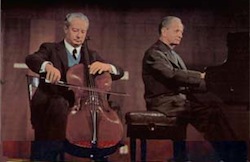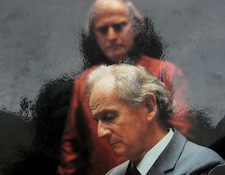Wilhelm Kempff fest tonight! I have the complete piano sonatas, cello sonatas with Pierre Fournier and violin sonatas with Yehudi Menuhin. Not sure if I will get through all of them tonight (15 CDs). These are some of my favorite recordings… ever.
The piano sonatas recording are wonderful. There are mistakes here and there (and this is the case on all these recordings) but all the performances feel very much like real performances (rather then recordings). The overall shaping of movements and whole pieces is wonderful, and you can tell that these are pieces that all of these performers know in their bones. It is performed as though these are great actors who have played a character to the point where they know the past, present, future, thoughts and motivations.
The sonatas box is probably the box set I sold the most of while working at Tower in the classical room. I also had a copy of it (a ‘defective’ copy) stashed away under the counter to play during my shifts. And not only are these some of the best recordings of the standards that most people look for (the ‘Moonlight’ and ‘Pathetique’ for instance), but the late sonatas are nothing short of stunning. The set I have (on DG) was the third recording of the complete Beethoven sonatas for Kempff. And the late sonatas especially benefit from this. They are introspective and have an extreme of touch to them – very light and floaty trills, and heavy dramatic octaves in the beginning of the Op. 111. The lyrical moments between the fugues in Op. 110 literally sound like someone singing a recitative, the piano practically breathing between utterances.
And as much as I LOVE the piano sonata recordings, the cello sonatas are even more special. The recordings are live, and show how well the two performers on stage know each other, and how well they both know Beethoven. The last movement of the op. 69 is a great example of this. The whole trajectory that leads up to the big climax near the end of the movement is paced temporally and dynamically in a perfect way. The whole movement swells and swells like a tide coming in… the waves slowly get larger and larger, and if you are a musician what would probably amaze you the most is how many levels of dynamics these players have. There seem to be four or five gradations between mezzo-forte and forte, and when they finally reach the climactic moment (together in octaves) it is an amazing moment. And the two Op. 102 sonatas feel like old familiar friends coming together again to share a lifetime of experience and understanding.
The violin sonatas lack the brilliance of the live cello sonatas, but keeps the feeling of old friends coming together. The pacing of most of the recordings are a little slower then normal, but the relaxed pacing works well for the two players. Nothing feels strained. The first movement of the ‘Kreutzer’, for instance, feels like two people sharing the drama of a story, but as a retelling of the drama. Most recordings of this piece have a sense of urgency, but here the urgency is replaced by the comfort that no matter how intense the music, everything will come out alright.



